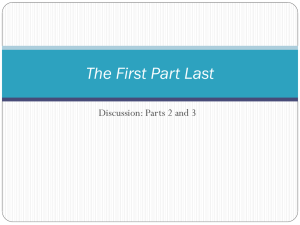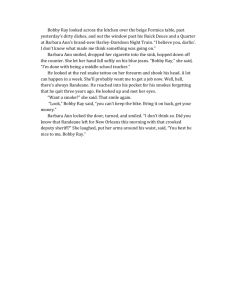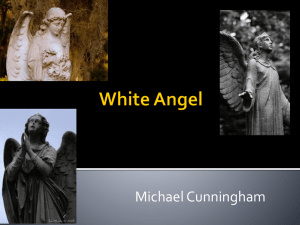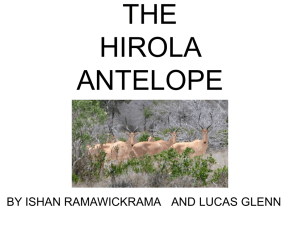An Indian Black Buck Antelope named Bobby
advertisement
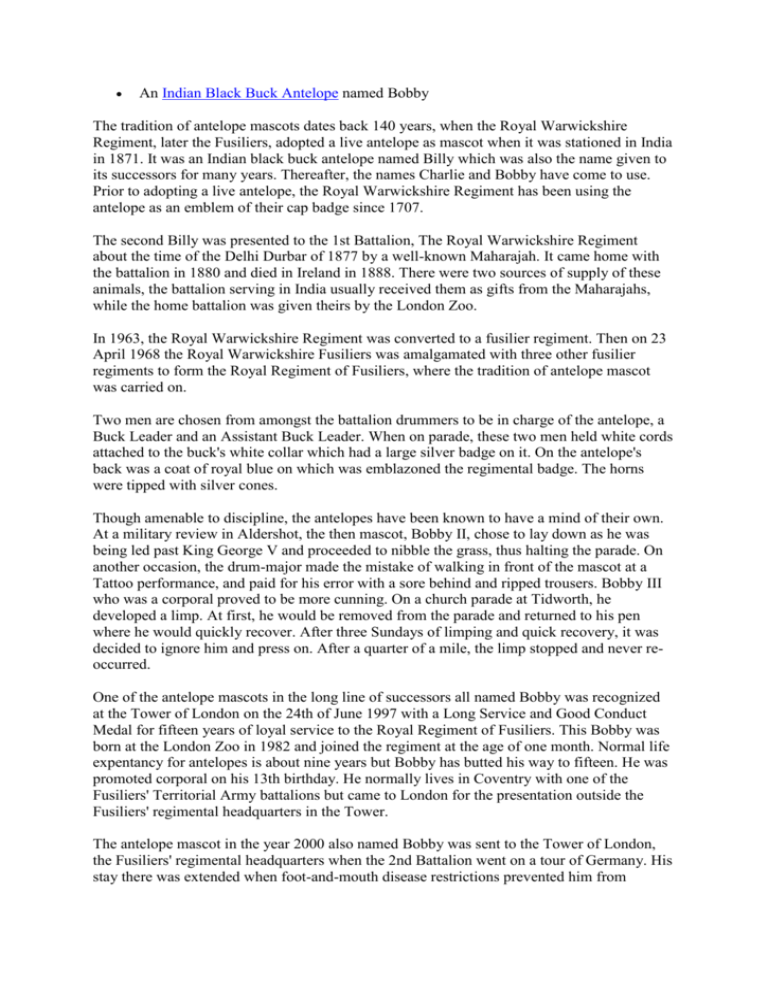
An Indian Black Buck Antelope named Bobby The tradition of antelope mascots dates back 140 years, when the Royal Warwickshire Regiment, later the Fusiliers, adopted a live antelope as mascot when it was stationed in India in 1871. It was an Indian black buck antelope named Billy which was also the name given to its successors for many years. Thereafter, the names Charlie and Bobby have come to use. Prior to adopting a live antelope, the Royal Warwickshire Regiment has been using the antelope as an emblem of their cap badge since 1707. The second Billy was presented to the 1st Battalion, The Royal Warwickshire Regiment about the time of the Delhi Durbar of 1877 by a well-known Maharajah. It came home with the battalion in 1880 and died in Ireland in 1888. There were two sources of supply of these animals, the battalion serving in India usually received them as gifts from the Maharajahs, while the home battalion was given theirs by the London Zoo. In 1963, the Royal Warwickshire Regiment was converted to a fusilier regiment. Then on 23 April 1968 the Royal Warwickshire Fusiliers was amalgamated with three other fusilier regiments to form the Royal Regiment of Fusiliers, where the tradition of antelope mascot was carried on. Two men are chosen from amongst the battalion drummers to be in charge of the antelope, a Buck Leader and an Assistant Buck Leader. When on parade, these two men held white cords attached to the buck's white collar which had a large silver badge on it. On the antelope's back was a coat of royal blue on which was emblazoned the regimental badge. The horns were tipped with silver cones. Though amenable to discipline, the antelopes have been known to have a mind of their own. At a military review in Aldershot, the then mascot, Bobby II, chose to lay down as he was being led past King George V and proceeded to nibble the grass, thus halting the parade. On another occasion, the drum-major made the mistake of walking in front of the mascot at a Tattoo performance, and paid for his error with a sore behind and ripped trousers. Bobby III who was a corporal proved to be more cunning. On a church parade at Tidworth, he developed a limp. At first, he would be removed from the parade and returned to his pen where he would quickly recover. After three Sundays of limping and quick recovery, it was decided to ignore him and press on. After a quarter of a mile, the limp stopped and never reoccurred. One of the antelope mascots in the long line of successors all named Bobby was recognized at the Tower of London on the 24th of June 1997 with a Long Service and Good Conduct Medal for fifteen years of loyal service to the Royal Regiment of Fusiliers. This Bobby was born at the London Zoo in 1982 and joined the regiment at the age of one month. Normal life expentancy for antelopes is about nine years but Bobby has butted his way to fifteen. He was promoted corporal on his 13th birthday. He normally lives in Coventry with one of the Fusiliers' Territorial Army battalions but came to London for the presentation outside the Fusiliers' regimental headquarters in the Tower. The antelope mascot in the year 2000 also named Bobby was sent to the Tower of London, the Fusiliers' regimental headquarters when the 2nd Battalion went on a tour of Germany. His stay there was extended when foot-and-mouth disease restrictions prevented him from returning to the 2nd Battalion's barracks. He was due to return to the Battalion's barracks in April 2001 but stayed in the Tower of London for 15 months. The present mascot is named Bobby and holds the rank of Corporal. He attends all major parades held by the Regiment. He lives with the 2nd Battalion, The Royal Regiment of Fusiliers in St. George Barracks, North Luffenham, Ruthland in Leicestershire. His pen is a converted tennis court with plenty of grass to graze. His regular diet is horse nuts and is partial to biscuits. He likes hour-long walks. This photo of 'Bobby II' was published in the Cavalry Journal in April 1940 but was probably taken some time in the mid1930s by the look of the uniforms. The text explains that the first black buck was originally acquired in India in 1871 and was named Billy. The name was given to its successors in the 1st Battalion for many years. Since then the names Bobby and Charlie have come into use. The second 'Billy' was presented to the 1st Battalion about the time of the Delhi Durbar of 1877 by a well-known Maharajah. It came home with the battalion in 1880 and died in Ireland in 1888. There were two sources of supply of these animals, the battalion serving in India usually received them as gifts from the Maharajahs, while the home battalion were given theirs by the London Zoo. The antelope was delivered in a wooden box and let loose in a big pen with a straw-lined hut in the corner. There was always water and rock salt in the pen and he was fed daily at 8.45am on two handfuls of crushed oats and bran, and about 2lbs of clover hay. Bobby II was partial to biscuits and sugar, and as a special treat..a cigarette (eaten, not smoked). Two men were chosen from amongst the battalion drummers to be in charge of the antelope, a Buck Leader and Assistant Buck Leader. When on parade these two men held white cords attached to the buck's white collar which had a large silver badge on it. On the animal's back was a coat of royal blue on which was emblazoned the regimental badge although a cigarette card of 1912 depicts the mascot as wearing a red coat. The horns were tipped with silver cones. Being a wild animal, there were times when Bobby II misbehaved. At a Tattoo performance the drum-major made the mistake of walking in front of the mascot and paid for his error with a sore behind and ripped trousers. On another occasion he was paraded before King George V and disgraced himself by lying down and nibbling the grass. Bobby III proved to be more cunning. On church parades at Tidworth he developed a limp. At first they would remove him from the parade and return him to his pen where he quickly recovered. After three Sundays of limping and quick recovery it was decided to ignore it and press on. After a quarter of a mile the limp stopped and never re-occurred. Bobby is back in his barracks Bobby was reunited with the troops after 15 months Bobby, the antelope army mascot, has rejoined his regiment after a 15-month stay in the Tower of London. The Indian black buck antelope is the mascot of The Royal Regiment of Fusiliers. He was sent to The Tower, the Fusiliers regimental headquarters, when 2nd Battalion went on a tour of Germany. He was forced into a longer stay when foot-and-mouth restrictions prevented him from returning to the battalion's barracks in North Luffenham, Rutland, Leicestershire. Life on the outside Bobby was welcomed back to the barracks by his handlers, Fusiliers Andrew Newton, 22, from Oldham, and Michael Griffin, 29, from Erdington, Birmingham on Friday. He will now be housed in a converted tennis court, although he is still confined to the barracks under current foot-and-mouth regulations. Major Peter Clarke, of 2nd Battalion, said: "We turned one of the tennis courts into a home for Bobby, and of course there is plenty of grass for him to graze on. "He certainly seems to be enjoying the wide open spaces and has settled down well to life on the outside." The tradition of antelope mascots dates back 150 years, when the Royal Warwickshire regiment, later the Fusiliers, adopted an antelope in India. Bobby took up his posting as mascot last year. He is said to like football and Nice biscuits and hour-long walks. Bobby was escorted from the Tower Bobby's handlers are delighted that he managed to find sanctuary from the livestock cull in a place more known for sending people to their deaths. Ian (Spud) Spooner and Dixie Dean with Bobby.
